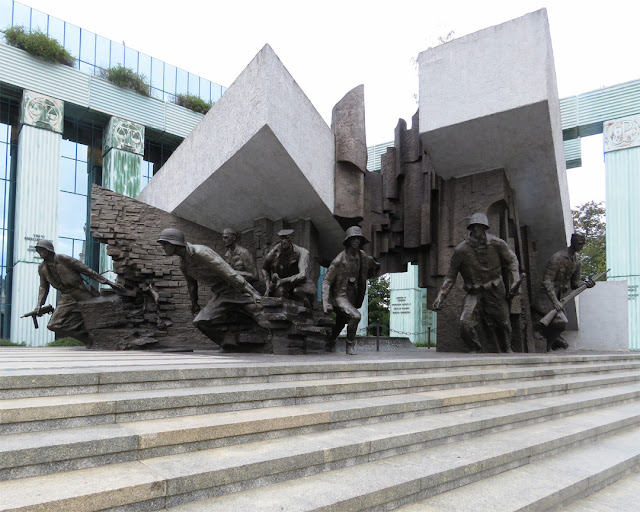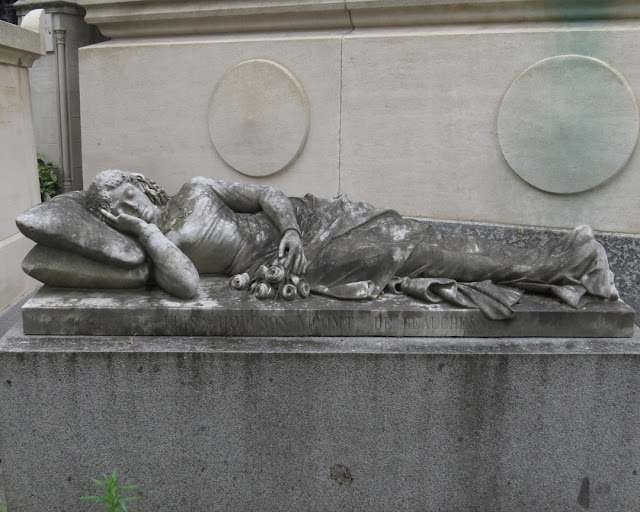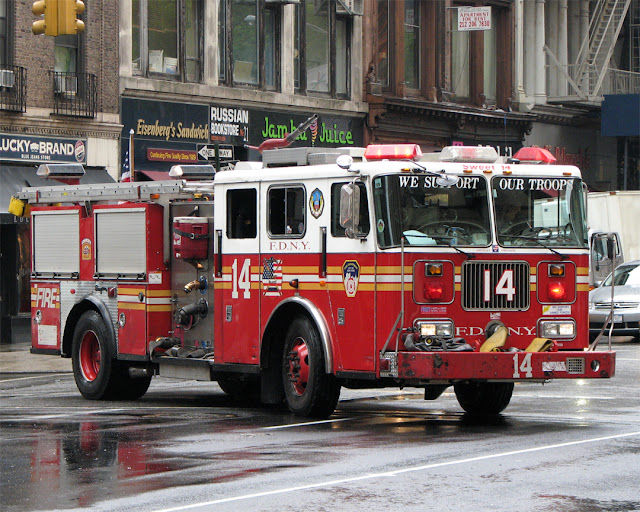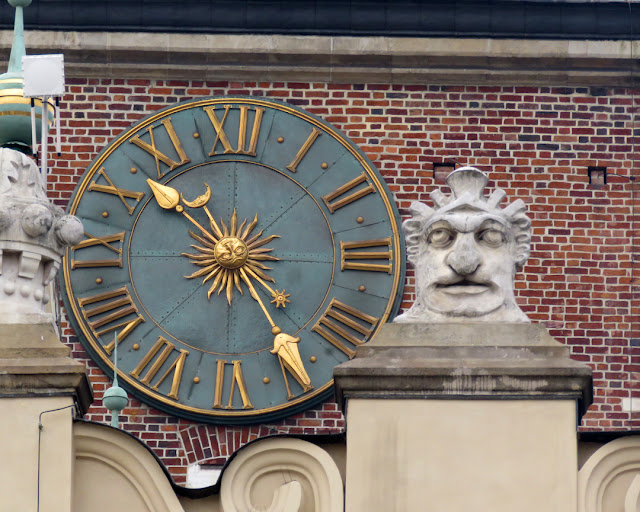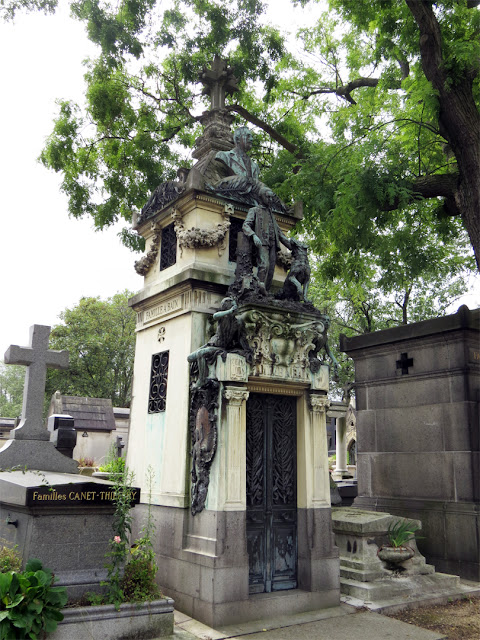Saturday, October 31, 2020
Polish eagle
Polish eagle
Neptune's Fountain by Abraham van den Blocke, 1617
Długi Targ (Long Market)
Gdańsk, September 2018
“The coat of arms of Poland is a white, crowned eagle with a golden beak and talons, on a red background. In Poland, the coat of arms as a whole is referred to as godło both in official documents and colloquial speech, despite the fact that other coats of arms are usually called an herb (e.g. the Nałęcz herb or the coat of arms of Finland). This stems from the fact that in Polish heraldry, the word godło (plural: godła) means only a heraldic charge (in this particular case a white crowned eagle) and not an entire coat of arms, but it is also an archaic word for a national symbol of any sort. In later legislation only the herb retained this designation; it is unknown why.” (Coat of arms of Poland, Wikipedia)
Friday, October 30, 2020
Hodie mihi, cras tibi
Hodie mihi, cras tibi (Today it's me, tomorrow it will be you)
Santa Maria dell'Orazione e Morte (Saint Mary of the Prayer and Death)
Via Giulia
Rome, June 2019
Thursday, October 29, 2020
Hell's Mouth
Boca do Inferno (Hell's Mouth)
Avenida Rei Humberto II de Itália
Cascais, April 2019
“Boca do Inferno (Portuguese for Hell's Mouth) is a chasm located in the seaside cliffs close to the Portuguese city of Cascais, in the District of Lisbon. The seawater has access to the deep bottom of the chasm and vigorously strikes its rocky walls, making it a popular tourist attraction. The cave was the first to be depicted in moving pictures, in the 1896 British film A Sea Cave Near Lisbon, which shows waves breaking at the mouth of the cave.” (Boca do Inferno, Wikipedia)
Wednesday, October 28, 2020
Warsaw Uprising Monument
Pomnik Powstania Warszawskiego (Warsaw Uprising Monument) by Wincenty Kućma, 1989
plac Krasińskich
Warsaw, September 2018
“Warsaw Uprising Monument (Pomnik Powstania Warszawskiego) is a monument in Warsaw, Poland, dedicated to the Warsaw Uprising of 1944. Unveiled in 1989, it was sculpted by Wincenty Kućma and the architect was Jacek Budyn. It is located on the southern side of Krasiński Square. The monument has been described as ‘the most important monument of post-war Warsaw.’ Gazeta Wyborcza reported in 2012 that it is one of the most visited landmarks for foreign tourists.” (Warsaw Uprising Monument, Wikipedia)
Tuesday, October 27, 2020
Pegasus
Pegasus by Aristodemo Costoli, 1865
Boboli Gardens
Piazza de' Pitti
Florence, January 2020
“Pegasus is a mythical winged divine horse, and one of the most recognized creatures in Greek mythology. Usually depicted as pure white, Pegasus is the offspring of the Olympian god Poseidon. He was foaled by the Gorgon Medusa upon her death, when the hero Perseus decapitated her. Pegasus is the brother of Chrysaor and the uncle of Geryon.Pegasus was caught by the Greek hero Bellerophon, near the fountain Peirene, with the help of Athena and Poseidon. Pegasus allowed Bellerophon to ride him in order to defeat the monstrous Chimera, which led to many other exploits. Bellerophon later fell from the winged horse's back while trying to reach Mount Olympus. Afterwards, Zeus transformed Pegasus into the eponymous constellation.” (Pegasus, Wikipedia)
Monday, October 26, 2020
Wavertree
“Wavertree” museum ship
South Street Seaport
Lower Manhattan
New York, September 2007
“Wavertree is a historic iron-hulled sailing ship built in 1885. Now the largest wrought iron sailing vessel afloat, it is located at the South Street Seaport in New York City. Wavertree was built in Southampton, England in 1885[2] and was one of the last large sailing ships built of wrought iron. She was built for the Liverpool company R.W. Leyland & Company, and is named after the Wavertree district of that city. The ship was first used to carry jute between eastern India and Scotland. When less than two years old the ship entered the "tramp trades", taking cargoes anywhere in the world. In 1910, after sailing for a quarter century, the ship was dis-masted off Cape Horn and barely made it to the Falkland Islands. Rather than re-rigging the ship its owners sold it for use as a floating warehouse at Punta Arenas, Chile. Wavertree was converted into a sand barge at Buenos Aires, Argentina in 1947. This ship was discovered in 1967 at the Riachuelo River in Buenos Aires by an American citizen working on a sand barge and acquired by the South Street Seaport Museum in 1968. The ship was sent to the Arsenal Naval Buenos Aires for restoration. In 1969 after restoration was complete, the ship was towed to New York. The vessel was added to the National Register of Historic Places on June 13, 1978.” (Wavertree, Wikipedia)
Sunday, October 25, 2020
Saturday, October 24, 2020
Friday, October 23, 2020
Thursday, October 22, 2020
Élisa Hodgson
Grave of Élisa Hodgson (1818-1882)
Cimetière du Père-Lachaise, (Père Lachaise Cemetery)
Quartier du Père-Lachaise, 20th arrondissement
Paris, July 2014
Wednesday, October 21, 2020
The Isolotto
The Isolotto
Boboli Gardens
Florence, January 2020
“The Isolotto is an oval-shaped island in a tree enclosed pond nearly at the end of the alternative Viottolone axis. In the centre of the island is the Fountain of the Ocean, while in the surrounding moat, there are statues of Perseus and Andromedae (school of Giambologna). The Isolotto was laid out (circa 1618) by Giulio and Alfonso Parigi.” (Boboli Gardens, Wikipedia)
Tuesday, October 20, 2020
Monday, October 19, 2020
Most im. Jana Pawła II
Most im. Jana Pawła II (Third Millennium John Paul II Bridge) by Krzysztof Wąchalski, 2001
Martwa Wisła
Gdańsk, September 2018
“The Third Millennium John Paul II Bridge is a cable-stayed road bridge which spans the Martwa Wisła River in Gdańsk, Poland. The bridge forms an inverted ‘Y’-shape with a 100-metre-tall pylon. Until Rędziński Bridge was opened on the 31 August 2011, it used to be the longest cable-stayed bridge in Poland supported by a single pylon. The bridge links the Northern Port of Gdańsk with the national road network and is the first section of the future by-pass road of the city of Gdańsk.” (Third Millennium John Paul II Bridge, Wikipedia)
Sunday, October 18, 2020
Piazza Santa Maria in Trastevere
Fountain
Piazza Santa Maria in Trastevere
Rome, June 2019
“The Fountain in Piazza Santa Maria in Trastevere is a fountain located in the square in front of the church of Santa Maria in Trastevere, Rome, Italy. It is believed to be the oldest fountain in Rome, dating back, according to some sources, to the 8th century. The present fountain is the work of Donato Bramante, with later additions by Gian Lorenzo Bernini and Carlo Fontana. A fountain is believed to have stood in this square since the 8th century, but the exact date it was built is unknown. The fountain is first mentioned in documents dating to the second half of the 15th century. A drawing of the fountain appears on the map of Rome made by Pietro del Massaio in 1471, along with a description of the legend of the fountain's origin. According to the legend, which appears in the Chronicle of Eusebius, translated and finished by Saint Jerome in the fifth century, on the night of the birth of Christ a fountain of oil appeared miraculously in front of the church, which as a result was given the name ‘Santa Maria in fontibus.’ The original fountain was supplied with water by a Roman aqueduct, the Aqua Traiana. When the aqueduct was ruined during the invasions of Rome, water came from underground sources below the Janiculum hill. The old fountain illustrated in the drawing of del Massaio had two vasques, one above the other, pouring water into the basin below. The fountain was reconstructed between 1499 and 1500 on the command of Giovanni Lopez, the bishop of Perouse and Bishop of the parish of Santa Maria in Trastevere, who gave the commission to Donato Bramante, the architect of St. Peter's Basilica. Bramante removed the upper vasque and added four carved stone wolf heads, the emblem of the Lopez family. The fountain was reconstructed again in 1604 by the architect Girolamo Rainaldi, the father of Carlo Rainaldi, the architect of the two churches of Piazza del Popolo. At that time the fountain was connected to the newly restored Acqua Felice aqueduct. In 1659 the fountain was connected to the Acqua Paola aqueduct and remodeled again by Bernini. Bernini replaced the octagonal basin, moved the fountain from its original place in front of the church to a new location in the center of the square, and added sculpted seashells around the basin. At the end of the 17th century, the architect Carlo Fontana replaced Bernini's seashells with his own sculpted seashells. The fountain was completely rebuilt in 1873, following the design of Bernini and Fontana, but using less expensive materials. In that occasion, the main pool was rebuilt with bardiglio marble and an imposing S.P.Q.R. sign has been placed on the external side of the shells. It was rebuilt once again in 1930. The last maintenance has been made in 1984.” (Fountain in Piazza Santa Maria in Trastevere, Wikipedia)
Saturday, October 17, 2020
Dom Carlos I de Portugal
Rei Dom Carlos I de Portugal
(King Carlos I of Portugal) by Luís Valadares, 2008
Avenida Dom Carlos I
Cascais, April 2019
Friday, October 16, 2020
Pałac Pod Blachą
Pałac Pod Blachą (Copper-Roof Palace)
plac Zamkowy
Warsaw, September 2018
“The Copper-Roof Palace (Polish: pałac Pod Blachą) is an 18th-century palace in Warsaw, Poland. It takes its name (which is less precisely phrased in the original Polish) from the copper roof, a rarity in the first half of the 18th century. Since 1989 the Palace has been a branch of the Royal Castle Museum. The palace is contiguous with Warsaw's Royal Castle, and down a slope from Castle Square and Warsaw's Old Town. Beneath the palace, a 17th-century lodge still exists.” (Copper-Roof Palace, Wikipedia)
Thursday, October 15, 2020
Abundance
Abundance (Johanna of Austria) by Pietro Tacca, 1536
Giardino di Boboli (Boboli Gardens)
Florence, January 2020
“The conceit here recalls the story of the competition of Athena and Neptune to be patrons of Athens. In that legend, Neptune struck the ground with his trident to spring forth water from the land. Higher up on the hillside is a statue of ‘Abundance’ (Dovizia).” (Boboli Gardens, Wikipedia)
Wednesday, October 14, 2020
Tuesday, October 13, 2020
Old clock
Old clock (Seen through Cloth Hall)
Wieża ratuszowa (Town Hall Tower)
Rynek Główny
Stare Miasto (Old Town)
Kraków, September 2018
“From the highest floor, visitors can admire a wonderful panoramic view of Krakow. Additionally, in the middle of the deck, there is an old clock mechanism that visitors have the opportunity to examine from inside. The mechanism of the clock is controlled by radio waves receiving the signals from the transmitter in Mainfligen, which gives it the accuracy of the atomic time standard. In the event of a power failure, the clock stops and sets back automatically to the correct time when the power is back on. Also, the clock sets a time change itself in accordance with daylight saving time.” (Town Hall Tower, Wikipedia)
Monday, October 12, 2020
Mosaic of the Annunciation
Mosaic of the Annunciation by Pietro Cavallini, 1291
Basilica of Our Lady in Trastevere
Piazza di Santa Maria in Trastevere
Rome, June 2019
“There are a number of 12th and late 13th-century mosaics in the basilica. Below are mosaics on the subject of the ‘Life of the Virgin’ by Pietro Cavallini (1291). Above is the mosaic representation of the ‘Coronation of the Virgin’ (1130–1143). The ‘Coronation of the Virgin’ sits atop an apse vault, and depicts Pope Innocent II holding a model of the church.” (Santa Maria in Trastevere, Wikipedia)
Sunday, October 11, 2020
Saturday, October 10, 2020
Robert Bain
Grave of Robert Bain (1891-1904)
Cimetière du Père-Lachaise, (Père Lachaise Cemetery)
Quartier du Père-Lachaise, 20th arrondissement
Paris, July 2014
Friday, October 9, 2020
Neptune of Boboli
Fontana del Nettuno (Neptune's fountain) by Stoldo Lorenzi, 1568
Giardino di Boboli (Boboli Gardens)
Florence, January 2020
“The main feature is a large basin with a central bronze statue of Neptune (1565-1568) by Stoldo Lorenzi. This fountain was being constructed contemporaneously with it more famous counterpart, Ammannati's Fountain of Neptune at the corner of the Palazzo Vecchio at the Piazza della Signoria in the center of Florence. The conceit here recalls the story of the competition of Athena and Neptune to be patrons of Athens. In that legend, Neptune struck the ground with his trident to spring forth water from the land.” (Boboli Gardens, Wikipedia)
Thursday, October 8, 2020
Church of the Guardian Angel
Church of the Guardian Angel
Tenth Avenue
Chelsea, Manhattan
New York, September 2007
“The Church of the Guardian Angel is a Roman Catholic church in the Roman Catholic Archdiocese of New York, located at 193 Tenth Avenue, Chelsea, Manhattan, New York City, New York. The present Southern Sicilian Romanesque-style brick church at 193 Tenth Avenue was built 1930 to the designs of John Van Pelt of Van Pelt, Hardy & Goubert. Plan were filed in 1929, and it was likely begun that year. Stylistically, it is similar to Van Pelt's other churches in Manhattan and the Bronx. The church design ‘is reminiscent of the early Romanesque sculpture at the abbey of Moissac. Both churches have a scalloped profile that seems to incorporate a bit of Moorish influence. Both the human and animal forms are treated with the same incredible flexibility...’ The AIA Guide to New York City (1988) writes ‘The church's simple brick and limestone Southern Sicilian Romanesque facade merges with the Tuscan village forms of auxiliary buildings to the north in a well- related group.’ AIA Guide to New York City (2010) describes the church as ‘lush brick and limestone, Italian Romanesque, backed up snug against the High Line. Despite the obvious difference in style and materials, the two were built around the same time.’” (Church of the Guardian Angel, Wikipedia)
Wednesday, October 7, 2020
Fontanna Czterech Kwartałów
Fontanna Czterech Kwartałów
(Four Quarters Fountain) by Ewa Koprowska and Lucyna Kujawa, 2009
ulica Grobla I
Stare Miasto (Old Town)
Gdańsk, September 2018
Tuesday, October 6, 2020
Trinità dei Monti
Church of the Santissima Trinità dei Monti (La Trinité-des-Monts)
Piazza della Trinità dei Monti
Rome, June 2019
“The church of the Santissima Trinità dei Monti, often called merely the Trinità dei Monti (French: La Trinité-des-Monts), is a Roman Catholic late Renaissance titular church in Rome, central Italy. It is best known for its position above the Spanish Steps which lead down to the famous Piazza di Spagna. The church and its surrounding area (including the Villa Medici) are a French State property. In 1494, Saint Francis of Paola, a hermit from Calabria, bought a vineyard from the papal scholar and former patriarch of Aquileia, Ermolao Barbaro, and then obtained the authorization from Pope Alexander VI to establish a monastery for the Minimite Friars. In 1502, Louis XII of France began construction of the church of the Trinità dei Monti next to this monastery, to celebrate his successful invasion of Naples. Building work began in a French style with pointed late Gothic arches, but construction lagged. The present Italian Renaissance church was eventually built in its place and finally consecrated in 1585 by the great urbanizer Pope Sixtus V, whose via Sistina connected the Piazza della Trinità dei Monti (outside the church) to the Piazza Barberini across the city. The architect of the facade is not known for certain, but Wolfgang Lotz suggests that it may have originated in a design by Giacomo della Porta (a follower of Michelangelo), who had built the church of Sant'Atanasio dei Greci, which has similarities, a little earlier. The double staircase in front of the church was by Domenico Fontana.” (Trinità dei Monti, Wikipedia)
Monday, October 5, 2020
Sunday, October 4, 2020
Saturday, October 3, 2020
Boboli obelisk
Boboli obelisk
Boboli Gardens
Florence, January 2020
“The Boboli obelisk, previously called the Obelisco Mediceo, is an ancient Egyptian granite obelisk, which was moved in the 18th century from Rome to Florence, where it was erected in the Boboli Gardens. The granite from which the obelisk is carved comes from Aswan and the inscriptions are dedicated to Atum, the deity of the city of Heliopolis. It is suspected to have been first erected in that city during the reign of Ramesses II. In the first century AD, it was moved to Rome by Domitian and placed in the Temple of Isis in the Campus Martius, along with three other obelisks still in Rome: the Obelisk at the Monument to those fallen at Dogali, the Obelisk of Piazza of the Pantheon, and the obelisk in front of Santa Minerva.” (Boboli obelisk, Wikipedia)
Friday, October 2, 2020
Thursday, October 1, 2020
Subscribe to:
Posts (Atom)




